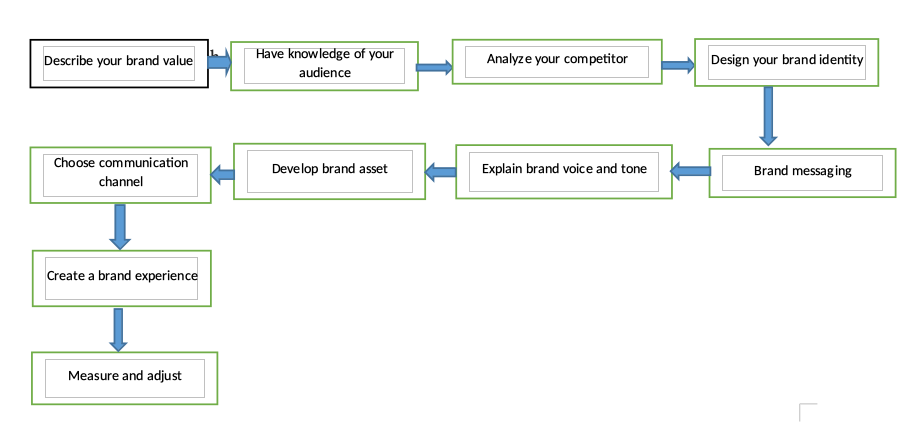Brand strategy is a plan to develop and manage a brand in order to achieve specific goals by defining the brand’s purpose, positioning, messaging, and key elements that differentiate it from competitors. It helps you build trust, loyalty, and recognition with your customers by communicating a consistent message all over.
Brand strategy help you connect with your customer in various ways as mentioned below:
- Explaining your Purpose and Values: A strong brand strategy expresses the brand’s purpose and values, helping customers understand what the brand represent and why it matters. This emotional connection can provide loyalty and trust.
- By identifying target audience: Brand strategy involves understanding the target audience and their needs, their likes, and behaviors. By forming and adjusting the brand’s messaging and offerings with customer needs, it becomes Important and attractive to them.
- Through creating consistency: A well-described brand strategy ensures consistency across all brand areas, from marketing materials to customer interactions. Consistency builds recognition and trust, making it easier for customers to connect with the brand.
- Establishes Distinction: Brand strategy helps identify what makes the brand different from competitors and communicates this effectively to customers. This differentiation helps the brand stand out in the market and gives customers a reason to choose it over others.
- Controlling communication: A clear brand strategy provides rules and principle on how the brand communicates with customers, including its tone of voice, messaging, and channels. This ensures that communication influences the target audience and strengthen the brand’s identity.
- Adapting to changes in the market: Brand strategy is flexible and adaptable, allowing the brand to evolve in case of new changes in the market or customer preferences. This helps the brand stay relevant and continue to connect with customers over time.
Overall, brand strategy is essential for building strong connections with customers by defining the brand’s purpose, understanding its audience, and communicating its value effectively. It serves as a roadmap for brand development and management, guiding decisions and actions that ultimately shape the customer experience.
Key elements of brand strategy
- Purpose: This is the reason why the brand exists beyond just making money. It shows how the mission, vision, and values align with customer’s needs. It shows why the brand exists and the purpose it communicates to customers by solving various problems faced by them.
- Target Audience: Having knowledge of the specific characteristics of the brand’s ideal customers and their environment is important for effective brand strategy. Understanding the target audience helps make messaging and contribution to meet their needs and likes.
- Positioning: This defines how the brand wants to be understood by customers as different from competitors. It involves identifying the brand’s unique value and communicating it clearly to differentiate it from others in the market and these things guide the brand behavior.
- Identification: Brand identity involves the tangible and intangible elements that represent the brand, including the logo, color, name, image, and overall design. Consistent branding across all areas helps build brand recognition and recall.
- Voice and Tone of the brand: This refers to the style, character, personality and manner in which the brand communicates with its audience. Establishing a different brand voice and tone helps create a consistent personality and build emotional connections with customers.
- Brand Messaging: Messaging includes implementing key messages that effectively communicate the brand’s values, benefits, and unique selling points to the target audience. These messages should support customer needs and desires while aligning with the brand’s identity.
- Brand Story: Stories are powerful tools for engaging and connecting with customers on an emotional level and showing how different we are from other brands. Brand storytelling involves using narratives to display the brand’s history, experience, equity, values, and purpose in a convincing and memorable way and drives long-term success.
How to create a brand strategy roadmap
- Describe your brand value and purpose
Start by explaining why your brand exist and the value it represents in the market. Start by asking yourself; what problems does your brand solve besides making profit and why should people consider and choose your brand over others.
- Have knowledge of your target audience
Here you have to do a market research to have a clear understanding of your target audience. Know their likes and dislikes, their long -term goal and what motivates them. Have a persona that will guide you to know your audience well to come up with a brand strategy and by doing so you will be able to set a price for goods and services that will be reasonable.
- Analyze your competitors
By researching your competitors, it will help you to know which gaps are in the market and how to fix them. Have a knowledge of their strength, weakness and how you can use the opportunities to differentiate your brand.
- Design your brand identity
Create a different brand identity that reflects your brand mission, vision, goals and personality; this includes coming up with a name, logo and color that will help capture the customers emotion connection to your goods and services.
- Create a coercive brand message
Create a clear and consistent message that shows the core values that you stand for, your personalities, missions that give customers an emotional connection to your goods and services. It should also focus on how you can solve customers’ problem and make their lives easy. The message should align with customers’ needs and preference.
- Explain brand voice and tone
Develop a brand voice that align and supports your audience. Define whether it’s friendly and conversational or authoritative and professional, consistency is paramount in all communication channels.
- Develop brand asset with automated tools
Make brand assets like website, social media profiles, marketing tools, packaging, and other materials that display your brand identity and messaging. Ensure consistency in design and messaging. Consider using adobe express because it allows you to save and easily add it to any social media graphics or marketing tools you make in the future without having to open any software.
- Choose Communication Channels
Determine the most effective communication channels to reach your target audience. This may include social media, email marketing, content marketing, advertising, public places, and events.
- Create a Brand Experience
Craft a memorable brand experience for your customers at every major areas, from the first interaction with your brand to post-purchase support. Focus on delivering value and building long-term emotional relationships and attachment with your audience.
- Measure and Adjust
Continuously monitor and measure the performance of your brand strategy with the use of KPIs (Key Performance Indicators). Gather feedback from customers and stakeholders, and be prepared to adjust your strategy as needed to stay relevant and competitive in the market.
By following these steps and continuously refining your brand strategy, you can create a strong and compelling brand that resonates with your target audience and drives long-term success.

\
Key Performance indicator (KIPs) in brand strategy
Have clear objectives
Come up with specific, measurable, achievable, relevant, and time-bound (SMART) objectives for your brand strategy. Clearly define what success looks like for your brand and how you will measure it and how they align with customers preferences.
Use a Mix of measures
Utilize a combination of qualitative and quantitative measures to determine different aspects of your brand’s performance. This can involve brand awareness, perception, equity, customer engagement, market share, and business results.
Benchmark against competitors
Compare your brand’s performance measures against those of your competitors to have a clue into your competitive position and identify various gaps and how to fill them.
Track measures over time
Monitor key performance indicators (KPIs) regularly and mark changes that comes over time to calculate the impact of your brand strategy and identify trends in the market.
Use surveys and feedback
Conduct surveys or interviews to collect feedback from customers, employees, and stakeholders about their views of your brand. Use this qualitative data to encourage quantitative measures and gain deeper views.
Monitor online and offline channels
Monitor brand mentions, feelings, and engagement across various online and offline channels, including social media, review sites and customer service interactions.
Measure Brand Loyalty
Assess customer loyalty measures such as continuous purchase rates, customer memory, and Net Promoter Score (NPS) to measure the level of loyalty your brand gains among customers.
Evaluate brand consistency
Conduct regular brand audits to ensure consistency in brand identity, messaging, and customer experience across various areas and communication channels.
Calculate ROI
Measure the return on investment (ROI) of your branding efforts by comparing the costs incurred with the benefits generated, such as increased revenue, customer accession, and future brand value.
Continuous calculation and adaption
Continuously review and analyze your brand performance measures, gather feedback, and be willing to adapt and calculate your brand strategy based on views and changing market trends.
Setbacks in brand strategy
- Lack of clear objectives
If your brand strategy lacks clear objectives, positioning, or messaging, it can lead to confusion among your target audience. This lack of clarity can delay brand awareness and connection.
- Inconsistent Brand Experience
Inconsistency in brand identity, messaging, and customer experience across different areas can weaken your brand’s effect and weaken its views in the market. It is important to ensure consistency to maintain brand integrity.
- Lack of alignment
If your brand strategy does not align with your target audience’s needs, values, or preferences, it may fail to attract and retain customers. Understanding your audience and defining your strategy accordingly is paramount.
- Competition
Intense competition in the market can bring challenges for your brand strategy, especially if your differentiation is not strong enough. Failing to differentiate your brand accordingly can lead to reduced market share.
- Negative views or Crisis:
Brand reputation can suffer from negative views, crises, or perceptions. Managing reputation effectively and responding to challenges is essential to reduce the impact on your brand.
- Limited Resources
Resources such as budget, time, or human resources can limit the implementation of your brand strategy. Giving resources a priority and optimizing their allocation can help overcome these limitations.
- Resistance to Change
Implementing a new brand strategy may face resistance from internal stakeholders, especially if it involves significant changes in processes, culture, or messaging. Effective communication and stakeholder involvement is important to gain their support.
- Lack of Innovation
In a changing market environment, brands that fail to innovate and evolve risk becoming stagnant or outdated. Accepting innovation and staying ahead of market trends is important for maintaining relevance and competitiveness.
Summary
By looking forward to addressing these setbacks and challenges, you can strengthen your brand strategy and increase its chances of success in the marketplace. Adaptability, resilience, and a customer-centric approach are key to overcoming obstacles and bringing about sustainable brand growth.

